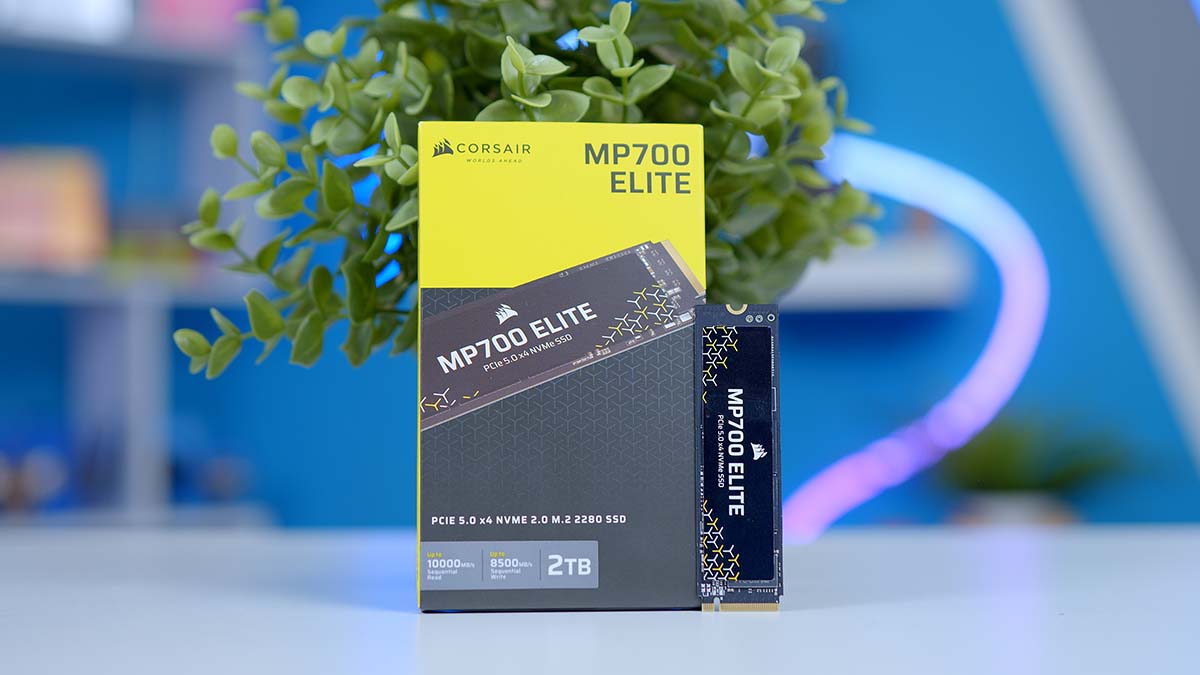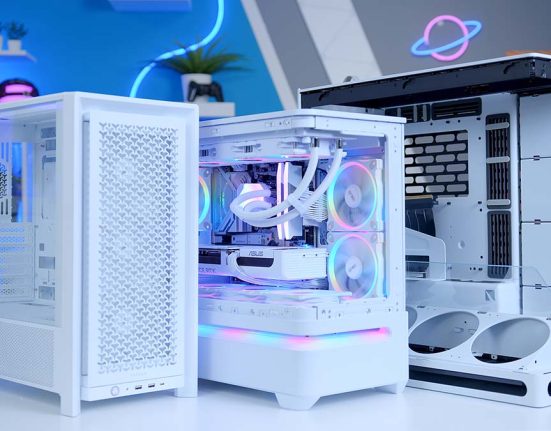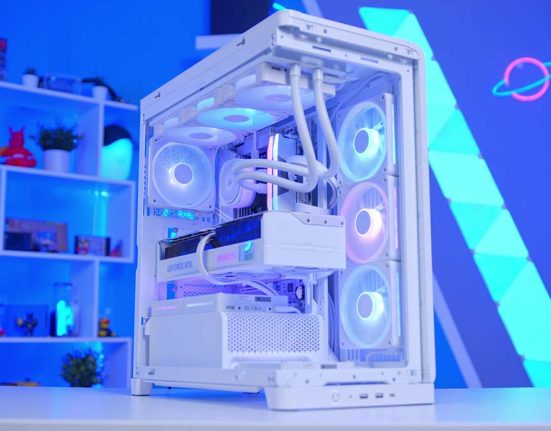The MP700 Elite has joined Corsair’s top-end range of MP700 Gen5 SSDs that offer ground-breaking speeds aimed at those looking to build an enthusiast system. Over the past year, we’ve seen a shift in the design of Gen5 storage, with newer drives offering a non-heatsink variant due to manufacturers figuring out how to keep temperatures at bay. This MP700 Elite drive is one of many SSDs to have taken the leap, hitting the shelves without a heatsink. Naturally, this raises potential concerns about temperatures. That’s why we’ve decided to test the MP700 Elite rigorously, assessing its speeds and temperatures to see how it performs.
New Gen5 SSDs are entering an incredibly competitive market. With Gen4 SSD prices at an all-time low and Gen5 SSDs saturating the space with a massive range of different choices, the latest drives need to bring unique features or impressive performance to the table. And while the speeds of the MP700 Elite are definitely impressive, they don’t quite match the 10GB/s or 12GB/s across the read and writes we’ve seen with other drives. This means that the MP700 Elite has its work cut out compared to the competition.
In this SSD review of the Corsair MP700 Elite, we’ll examine the specs, design, thermals, and performance in depth to determine whether this drive is a worthwhile purchase at its price point.
Buy the Corsair MP700 Elite on:
Specification
Specs-wise, the Corsair MP700 Elite is a Gen5 M.2 SSD using four PCI-E lanes versus a drive like the Samsung 990 EVO, which only uses two. Because it uses four lanes, this drive offers a maximum read speed of 10000MB/s, while writes sit at 8500MB/s. These speeds are available across the 1TB and 2TB variants, which is great. Manufacturers often limit speeds based on capacity, so it’s excellent that you can pick up a cheaper drive that still offers good speeds.

It’s worth highlighting that the performance of the Corsair MP700 Elite isn’t the most impressive we’ve seen. Earlier this year, Corsair released their MP700 Pro SE, which maxes out at 14000MB/s and 12000MB/s on the read and writes, respectively. Ultimately, this is one of the pricier Gen5 drives on the market, but it still serves as a good point of comparison.
Unfortunately, the MP700 Elite’s biggest competitors are drives like the Crucial T700, TeamGroup T-Force GC Pro, and Corsair’s MP700 Pro, all of which are cheaper and offer better speeds.
| Specification | Corsair MP700 Elite |
|---|---|
| PCI-E Generation | Gen5 |
| Capacity | 1TB 2TB |
| Sequential Read Speed | 10000MB/s |
| Sequential Write Speed | 8500MB/s |
| Warranty | 5 years |
| Endurance | 1TB: 600TBW 2TB: 1200TBW |
| Form Factor | M.2 2280 |
Despite this, there are some qualities that make the MP700 Elite stand out compared to other drives. It has a five-year warranty as standard, leaving plenty of breathing room to leverage a return or RMA should the drive be faulty. Endurance is pretty standard for a drive of this calibre. Most SSDs tend to sit around 400-700TBW (terabytes written) for 1TB drives, and then this doubles with 2TB, 4TB, and so on. Either way, the 1200TBW on the 2TB version is decent regarding endurance.
Price-wise, the non-heatsink versions, in 1TB and 2TB capacities, have MSRPs of $144.99 and $249.99, respectively. Gen5 SSDs are generally expensive, so it’s no surprise to see a $250 price tag on the 2TB drive. However, as mentioned earlier, the MP700 Elite has some tough competition at this price point.
Corsair MP700 Elite Design
As a non-heatsink drive, the Corsair MP700 Elite is fairly barebones in design. Manufacturers don’t tend to prioritise aesthetics on cheaper variants of M.2 SSDs, hence the no-frills look of this storage option. There are no fans, RGB, or wires; the MP700 Elite is simply an M.2 drive.

The MP700 Elite utilises the 2280 form factor, which is standard for most modern desktop NVMe drives that have hit the shelves in the past couple of years. Because it uses the 2280 form factor, this drive will have no issues slipping into an X870(E) or Z890 motherboard.
A small label on the top of the drive sits on the flash chips. This label provides a better surface area to dissipate high temperatures, helping to transfer heat. Again, this is pretty common for an SSD without a heatsink. It would be nice to see some RGB lighting on the MP700 Elite, making the drive stand out more. However, I’d be worried that this would further increase the expensive price.

It’s worth noting that while there isn’t an integrated heatsink or fan on the MP700 Elite, Corsair recommends placing this drive under a motherboard heatsink. Gen5 SSD thermals aren’t a significant issue since manufacturers have solved the temperature problem. However, due to the read and write speeds, these drives still run hot, so installing this drive without a motherboard heatsink would be ill-advised as you run the risk of thermal throttling, which results in weaker performance.
Gen4 vs Gen5 – Is There a Difference?
One of the significant issues with purchasing new hardware is determining whether there’s any substantial benefit to performance bar a couple of extra frames or 0.1ms quicker boot times. So, this raises the question: Is there a considerable difference between Gen4 and Gen5 SSDs regarding performance? Unfortunately, the answer is a bit of a mixed bag.
If we’re looking at straight gains in day-to-day tasks, game load times, or just booting up your PC, the answer is no. We’ve tested this previously and concluded that the difference is minimal. The reason is that modern titles don’t fully utilise the read-and-write capability of the latest drives, so the difference is pretty negligible.
Some modern titles have made changes to improve this, such as the inclusion of the DirectStorage API, which loads assets from high-bandwidth storage. But because so few games use this technology, we’re not seeing a massive benefit from it.
On the other hand, there are benefits to owning storage that provide blazing-fast speeds. The first is for content creation. If you produce 4K or 8K video content, the files will be large. So, transferring these at rapid speeds is great from a productivity point of view. Alternatively, if you have a home server or something like a Steam caching server for games, Gen4 and Gen5 drives are ideal for storage because they can quickly read and write data. To summarise, there are clear benefits to owning Gen4 and Gen5 drives, but unless your use case requires explicitly high speeds, it may be worth picking up a cheaper option.
Thermals
To determine the MP700 Elite’s thermals, we ran CrystalDiskMark and HWMonitor to monitor temperatures. CrystalDiskMark applies an artificial load by transferring files of a specific size to your drive of choice. Once complete, it returns measurements of the sequential and random reads and writes. HWMonitor then allows us to gauge temperatures while the MP700 Elite is under a sustained workload.
During our benchmark, we saw an average temperature of 76°C, which the MP700 Elite held firmly during 100% utilisation. It then dropped back down to 66°C with idle holding around 55°C. Ultimately, the temperatures here aren’t mindblowing. The MP700 Elite didn’t thermal throttle, which is ideal, but the 76°C average is quite toasty and will impact overall system temperatures.

It is worth highlighting that this uses a motherboard heatsink, which is somewhat impressive. But because a range of drives can maintain similar temperatures in the same situation, we weren’t blown away.
Performance
To find out what speeds the MP700 Elite offers, we ran CrystalDiskMark, which is a staple application that features across all of our SSD benchmarks. This provides us with sequential read and write speeds measured in ‘MB/s’ (megabytes per second), which indicates how the MP700 Elite will handle games and day-to-day usage.
Regarding performance, the MP700 Elite slightly overperformed compared to its rated speeds. Corsair details a maximum of 10000MB/s on the reads and 8500MB/s on the writes. In our benchmarks, the reads reached 10207MB/s and writes hit 8983MB/s. This is around a 3.5% performance improvement across the board, which will be ideal if you’re a content creator benefitting from blazing-fast reads and writes.

These results are also well within any margin of error, in which we typically allow 10% over or under for our results. Either way, the benchmarking speeds remain close to Corsair’s advertised numbers.
When compared to the other Gen5 SSDs we’ve tested, the Corsair MP700 Elite ranks 6th, in between the Seagate Firecuda 540, which has better write speeds, and the Crucial T700, which maxes out around the 12GB/s mark.

Conclusion
Corsair MP700 Elite
Product Name: MP700 Elite
Brand: Corsair
-
Design
-
Thermals
-
Performance
-
Value For Money
Summary
The Corsair MP700 Elite is a Gen5 drive with decent speeds and reasonable thermals, allowing you to install it underneath a motherboard heatsink easily. But these are the only things this drive has going for it. The biggest issue with the MP700 Elite is that as soon as we compare it to alternative options on the market, it isn’t a drive worth picking up. It doesn’t compete with any of the existing Gen5 SSDs when it comes to pricing, and it is easily beaten out by other drives regarding read and write speeds.
This puts the MP700 Elite in a precarious market position because it doesn’t have much to offer compared to other drives. Competitors like the Crucial T700 and Seagate Firecuda 540 are better options if you’re looking for a substantial value Gen5 SSD at a similar price. If Corsair had positioned the MP700 Elite as a cheaper and slightly slower Gen5 SSD, it likely would have stood out as a solid drive for a mid-range or less expensive high-end build. But as it currently stands, we’d recommend looking at the alternatives until this drive comes down in price.
Pros
✅ Decent thermals
✅ Outperforms rated speeds
✅ No massive heatsink
Cons
❌ Performance versus other drives
❌ 2TB max capacity
❌ Expensive



![FI_[DM78] Corsair Air 5400 + 5090 Gaming PC Build](https://geekawhat.com/wp-content/uploads/2025/11/FI_DM78-Corsair-Air-5400-5090-Gaming-PC-Build-551x431.jpg)
![FI_[DP051] Antec C5 + 5070Ti Gaming PC Build](https://geekawhat.com/wp-content/uploads/2025/11/FI_DP051-Antec-C5-5070Ti-Gaming-PC-Build-551x431.jpg)


![FI_[DM76] HAVN BF360 5090 Build](https://geekawhat.com/wp-content/uploads/2025/10/FI_DM76-HAVN-BF360-5090-Build-1-551x431.jpg)
